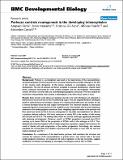Por favor, use este identificador para citar o enlazar a este item:
http://hdl.handle.net/10261/3415COMPARTIR / EXPORTAR:
 SHARE SHARE
 CORE
BASE CORE
BASE
|
|
| Visualizar otros formatos: MARC | Dublin Core | RDF | ORE | MODS | METS | DIDL | DATACITE | |

| Título: | Perlecan controls neurogenesis in the developing telencephalon |
Autor: | Girós, Amparo; Morante, Javier CSIC ORCID ; Gil-Sanz, Cristina CSIC ORCID; Fairén, Alfonso CSIC; Costell, Mercedes | Fecha de publicación: | 5-abr-2007 | Editor: | BioMed Central | Citación: | BMC Dev Biol. 2007; 7: 29 | Resumen: | [Background] Perlecan is a proteoglycan expressed in the basal lamina of the neuroepithelium
during development. Perlecan absence does not impair basal lamina assembly, although in the 55%
of the mutants early disruptions of this lamina conducts to exencephaly, impairing brain
development. The rest of perlecan-null brains complete its prenatal development, maintain basal
lamina continuity interrupted by some isolated ectopias, and are microcephalic. Microcephaly
consists of thinner cerebral walls and underdeveloped ganglionic eminences. We have studied the
mechanisms that generate brain atrophy in telencephalic areas where basal lamina is intact. [Results] Brain atrophy in the absence of perlecan started in the ventral forebrain and extended to lateral and dorsal parts of the cortex in the following stages. First, the subpallial forebrain developed poorly in early perlecan-null embryos, because of a reduced cell proliferation: the number of cells in mitosis decreased since the early stages of development. This reduction resulted in a decreased tangential migration of interneurons to the cerebral cortex. Concomitant with the early hypoplasia observed in the medial ganglionic eminences, Sonic Hedgehog signal decreased in the perlecan-null floor plate basal lamina at E12.5. Second, neurogenesis in the pallial neuroepithelium was affected in perlecan deficient embryos. We found reductions of nearly 50% in the number of cells exiting the cell cycle at E12–E13. The labeling index, which was normal at this age, significantly decreased with advancing corticogenesis. Moreover, nestin+ or PCNA+ progenitors increased since E14.5, reaching up to about 150% of the proportion of PCNA+ cells in the wild-type at E17.5. Thus, labeling index reduction together with increased progenitor population, suggests that atrophy is the result of altered cell cycle progression in the cortical progenitors. Accordingly, less neurons populated the cortical plate and subplate of perlecan-null neocortex, as seen with the neuronal markers β-tubulin and Tbr1. [Conclusion] As a component of the basal lamina, perlecan both maintains this structure and controls the response of the neuroepithelium to growth factors. Less mitotic cells in the early medial ganglionic eminences, and impaired cell cycle progression in the late neocortex, suggests insufficient recruitment and signaling by neurogenic morphogens, such as SHH or FGF2. |
Descripción: | This article is available from: http://www.biomedcentral.com/1471-213X/7/29 | URI: | http://hdl.handle.net/10261/3415 | DOI: | 10.1186/1471-213X-7-29 | ISSN: | 1471-213X |
| Aparece en las colecciones: | (IN) Artículos |
Ficheros en este ítem:
| Fichero | Descripción | Tamaño | Formato | |
|---|---|---|---|---|
| picrender.pdf | 4,3 MB | Adobe PDF |  Visualizar/Abrir |
CORE Recommender
PubMed Central
Citations
42
checked on 19-mar-2024
SCOPUSTM
Citations
78
checked on 24-abr-2024
WEB OF SCIENCETM
Citations
75
checked on 24-feb-2024
Page view(s)
400
checked on 24-abr-2024
Download(s)
280
checked on 24-abr-2024
Google ScholarTM
Check
Altmetric
Altmetric
Artículos relacionados:
NOTA: Los ítems de Digital.CSIC están protegidos por copyright, con todos los derechos reservados, a menos que se indique lo contrario.
